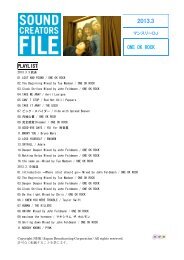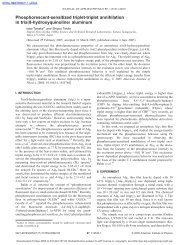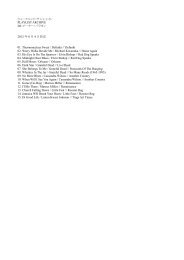Children's Television: Trends Around the World
Children's Television: Trends Around the World
Children's Television: Trends Around the World
Create successful ePaper yourself
Turn your PDF publications into a flip-book with our unique Google optimized e-Paper software.
CHILDREN’S TELEVISION: TRENDS AROUND THE WORLD<br />
123<br />
simply with children winning points. Instead, <strong>the</strong>y are intended to foster intellectual<br />
curiosity by devising questions that reflect children’s genuine concerns<br />
and devoting ample time to explaining <strong>the</strong> answers. An example of this is Just<br />
Super!, broadcast by Germany’s ZDF. Just Super! is a current affairs and science<br />
quiz show where opponents compete to answer <strong>the</strong> most questions.<br />
However, <strong>the</strong> key feature of <strong>the</strong> show is not <strong>the</strong> winning or losing, but <strong>the</strong><br />
verification of <strong>the</strong> answers. To check whe<strong>the</strong>r an answer is correct, <strong>the</strong> studio<br />
is suddenly transformed, mid-game, into, for example, a chemistry laboratory.<br />
Adapting science for children’s television in this way is a strong point of<br />
ZDF.<br />
Magazine Programs<br />
The U.S. children’s magazine program, ZOOM, is produced by WGBH<br />
Boston, one of <strong>the</strong> leading players in American public broadcasting. True to<br />
its motto, “by kids, for kids,” <strong>the</strong> series is run by children. Its website has<br />
drawn much attention in recent years, winning numerous festival prizes<br />
including <strong>the</strong> very first Grand Prix for websites in <strong>the</strong> 2000 Prix Jeunesse<br />
International. The program draws on <strong>the</strong> experiences of a similar program of<br />
<strong>the</strong> same title aired in <strong>the</strong> 1970s, when <strong>the</strong> child viewers’ parents <strong>the</strong>mselves<br />
were elementary school children. In those days, children communicated <strong>the</strong>ir<br />
views of <strong>the</strong> program by means of letter, telephone, or fax. Now, in <strong>the</strong> age of<br />
<strong>the</strong> Internet, <strong>the</strong> program itself is not <strong>the</strong> only vehicle for reflecting children’s<br />
input; <strong>the</strong> website offers an arena for children to communicate with each<br />
o<strong>the</strong>r, and to discover <strong>the</strong> fun of learning by accessing <strong>the</strong> vast online store of<br />
information.<br />
Ano<strong>the</strong>r long-running children’s magazine program is <strong>the</strong> BBC’s Blue<br />
Peter, which began in 1958. In this show, too, children’s participation has<br />
always been integral. This feature now naturally extends to interaction with<br />
<strong>the</strong> Blue Peter website.<br />
Real-life Activities in <strong>Television</strong><br />
A number of programs for preschoolers have been very successful in integrating<br />
scenes of real-life children’s activities. The idea is that children will be<br />
motivated by television images of children exploring <strong>the</strong>ir environment. An<br />
example is Deksels, a cooking program for children, filmed by <strong>the</strong> Dutch public<br />
broadcaster KRO and broadcast on <strong>the</strong> children’s channel, Z@ppelin. Each<br />
episode is six-and-a half minutes long, and shows two five-year-olds at work<br />
in <strong>the</strong> kitchen, preparing some food of <strong>the</strong>ir own choice (peanut butter, in one<br />
episode). The activity ensues without narration; only simple background<br />
music accompanies <strong>the</strong> children’s trial-and-error-based progress. There is no







